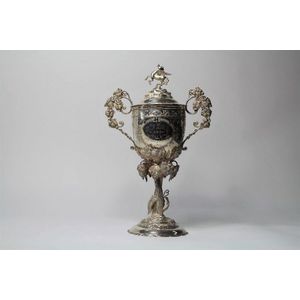Kayser Jugendstil Silver Plated Centrepiece with Mermaid and Putti
You must be a subscriber, and be logged in to view price and dealer details.
Subscribe Now to view actual auction price for this item
When you subscribe, you have the option of setting the currency in which to display prices to $Au, $US, $NZ or Stg.
- Foliate - Decorated with leaves or leaf-like forms.
- Jugendstil - The German and Austrian version of the Art Nouveau style and the other related styles that were expanding everywhere in Europe in the early 20th century.
The name was derived from the title of the Munich cultural magazine, "Die Jugend", with the addition of "Stil", which translates as "youth style".
Jugendstil encompasses all forms of architecture and art: industrial facilities, elevated-train systems, villas, churches, as well as the interior design of bars and coffee houses
In Austria, Jugendstil developed also in various ways, mainly under the effect of the Viennese Secession and of the Wiener Werkstätte. - Cornucopia - The cornucopia, literally the horn of plenty, is a symbol of abundance and wealth. It is traditionally is represented by a curved goat horn overflowing with grain and fruit.
Modern cornucopias are often depicted as horn-shaped baskets filled with food, and this symbol is often associated with the harvest. This decorative device has a long and ancient history, with roots in Greek mythology.
In one version, when Zeus was playing with the goat Amalthea he accidentally broke off one of her horns. To atone for this, Zeus promised Amalthea that the horn would always be full of whatever fruits she desired. This became the cornucopia of the Roman goddess Copia, the personification of plenty. Other goddesses, including Fortuna and Pax, also held the cornucopia.
In furniture and decorative arts, cornucopia as a decorative element have been popular since the 16th century and can be found on items as diverse as light fittings and candelabra to clocks, sculpture and statuary and furniture.
In ceramics, cornucopia shaped vases were popular in the 19th century, in singles and pairs. - Putto / Putti / Amorino / Amorini - A putto (plural: putti) or amerino (plural: amerini) is a cherub or cupid frequently appearing in both mythological and religious paintings and sculpture, especially of the Renaissance and Baroque periods and later used as a decorative element in the design of furniture, ceramics, statuary etc. They are usually depicted as chubby males, or of indeterminate gender, often with wings. Their depiction may represent an association with love, heaven, peace or prosperity.
This item has been included into following indexes:
Visually similar items

Antique Australian silver lidded trophy cup by Edward Fischer, inscribed Geelong College Cup, 1883 won by J F Holloway, the cup body supported by two entwined thick grape vines with leaf form cradle, supporting the main cup bowl, applied twin handles of do

A shell form salt - possibly silver

A Russian brass samovar with six tea holders and five tea glasses, plus teapot

A Victorian silver plate tea urn, circa 1860, 48 cm high
